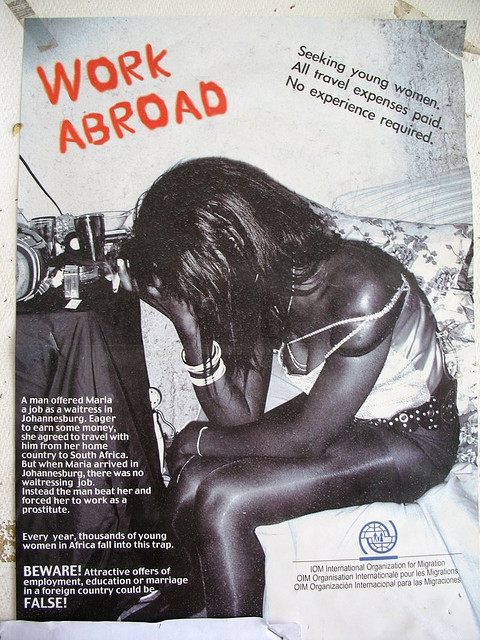 A shocking truth
A shocking truth
Usually, when one thinks about human trafficking, one imagines people, mostly women and children, sold to organized crime or lured with false promises of a well-paying job abroad. This perception is fairly accurate since, worldwide, 70-80 percent of trafficked persons are women and half of them are children; but men are also trafficked. Most people think human trafficking plagues poor regions, and for the most part, that’s true: Malaysia, Thailand, Central Africa, Eastern Europe and… Canada? No, of course not. No one ever associates human trafficking with a wealthy, stable, democratic country, and neither did I, until recently.
Not only are Western Countries, including Canada, the main importers of modern-day slaves, but their own people are trafficked inside their borders. The horrors of human exploitation do not occur only very far away. Look around you: brothels and massage parlours are just two of the exploiters taking advantage of human trafficking right here, right in front of us.
According to the Royal Canadian Mounted Police, 800 to 1200 persons are trafficked every year to Canada and 1500 to 2200 persons are trafficked through Canada into the United States. In Canada, trafficking for prostitution alone was estimated to be worth $400 million annually in 2004 and the numbers have gone up since then.
Human trafficking is not just about prostitution, Although 80 percent of trafficking involves sexual exploitation, 19 percent of the victims are used for forced labour (sweatshop and agricultural work as well as domestic servitude). Victims of human trafficking are usually prevented from leaving through isolation, violence, threats of deportation, debt bondage, etc. They very often suffer extreme mental and physical abuse.
Whilst “classic” slavery was abolished in Canada over 200 years ago, a new form of slavery – human trafficking – has now come to be the second largest criminal industry after drug dealing and seems to be growing at an alarming rate. How is our government dealing with the problem?
In 2002, Canada signed the UN Protocol to Prevent, Suppress and Punish Trafficking in Persons, especially Women and Children – the first legally binding document with an agreed definition on trafficking in persons. The purpose of this protocol was to help Canada and the other signatories establish domestic criminal offences against Human Trafficking for an easier international cooperation, and to protect the victims of trafficking.
But even though laws were created since then and even though provincial actions were taken – such as the creation of the Office to Combat Trafficking in Persons in British Columbia – the situation is getting worse.
Why? Simply because we are not aiming at what we should.
First, inform
Increasing the population’s awareness about the issue of Human Trafficking is the first step to a change.
Here in Montreal, the Temple against Human Trafficking is perhaps the most active and successful group in informing the citizens. An offshoot of the women’s committee at the Temple Emanu-El-Beth Sholom in Montreal, they frequently join forces with other groups that include laypeople from St. Monica’s Parish in Notre Dame de Grace, the Sisters from the Congregation of Notre Dame and the Congregation of the Holy Names of Jesus and Mary. The Temple has hosted 5 conferences in the past 5 years on different issues concerning human trafficking. They have managed to reach a wide array of audiences ranging from high school students, to other NGOs, to heads of the RCMP, and what is more, the discussions held during these conferences have led to a debate in society as to what solutions should be adopted to combat human trafficking. It is undoubtedly through such discussions that new ideas are forged and that effective action can begin. We need more of these events, and we need them in all the major cities across Canada. But without governmental assistance and financial support, there is only so much that all the good-willed NGOs can do.
The Canadian government has recently made some very good first steps however when the Minister of Public Safety, Vic Toews, launched the “Blue Blindfold” national campaign on September 7, 2010 in Winnipeg. In partnership with the Canadian Crime Stoppers Association (CCSA), the RCMP Human Trafficking National Coordination Centre (HTNCC) and Public Safety Canada, the Blue Blindfold campaign will raise public awareness through advertising and other public education programs.
More can certainly be achieved by reaching wider segments of the population through the Media and through the organization of talks in Universities. It is not an impossible task and the more we know, the more we can do.
Second, attack the cause
A few years ago, some countries tried legalizing prostitution in an effort to fight human trafficking, but instead of curbing down the prostitution rates and limiting human trafficking, this approach only caused an increasing involvement of organized crime in the sex industry, a dramatic increase in child prostitution, and an explosion in the number of foreign women and girls trafficked in the regions where the legalization was adopted: Germany, Netherlands, Australia. (University of London study, 2003)
Human trafficking should be looked at from a different angle: sex trade constitutes a great part of it and demand lies at the very root of the explosion of the sex trade. We can get a good grasp of that simply by looking at how human trafficking increases during major international events (e.g. Vancouver Olympics 2010) when demand for sexual services reaches peaks. Thus, to fight human trafficking we would have to specifically fight demand, like Sweden successfully started doing 10 years ago. Sweden’s plan was very simple: criminalizing the buying of sex and decriminalizing the selling of sex. Through this change in legislation, prostitution started being regarded as a form of male violence against women and children; as an injustice needing to be rectified rather than an illegal but accepted form of work. Coupled with this, Sweden invested in effective social programs to help the victims of sex slavery get out of their miserable situations. Sweden is now, of all its neighbours, the country with the lowest rate of prostitution and with the fewest problems regarding human trafficking. The social programs for the victims, even more so than the change in legislation, have really been the key to success.
Here in Canada, victims of trafficking are too often placed in detention facilities and then deported, instead of being given assistance and support. There are few shelters dedicated to human trafficking victims and limited funds to provide them, for example, with income generating opportunities.
To achieve results like those of Sweden, a change in mentality, including a greater push on the part of citizens for equality would be necessary. First, we would have to stop seeing sex slavery, including prostitution, as a dirty problem too marginal to be discussed; and then we could start helping the victims.
A prospect for the future
Last year, the US Trafficking in Persons Report concluded that ”[Canada’s] Government fully complies with the minimum standards for the elimination of trafficking.”
Canada should not satisfy itself with complying with minimum standards when it can generate new ideas to fight human trafficking at home and abroad and become an example to follow.
Manitoba MP Mrs Joy Smith is of that opinion and has worked tirelessly to effect change. In June 2010 she succeeded in getting Bill C268 passed by the Senate: anyone found guilty of trafficking children will now spend a minimum of 5 years in prison (there was no such minimum before). At the beginning of September, Mrs Smith also unveiled a series of recommendations for a National Plan to combat human trafficking. She strongly supports following Sweden’s example in changing our laws and mentalities.
Her efforts are exactly what Canada needs and hopefully more MPs and our Prime Minister himself will soon join the fight.
The Canadian government should be a leader and take strong action to assist and care for the most vulnerable members of society, namely those weak enough to become victims of human trafficking.
27 million is the estimated number of slaves worldwide today.
Let us react before millions more get enslaved
. CR
 Isabelle Sokolnicka is a 2010 PitR alumna and a student of Political Science at McGill University. She enjoys dancing, music and all other forms of arts, as well as any new language she can learn – she fluently speaks 4 and is learning 3 others. Her biggest passion though is travel and adventure. She spent the summer working for a Human Rights organization in South Africa where she discovered a breathtakingly beautiful country and its amazing people.
Isabelle Sokolnicka is a 2010 PitR alumna and a student of Political Science at McGill University. She enjoys dancing, music and all other forms of arts, as well as any new language she can learn – she fluently speaks 4 and is learning 3 others. Her biggest passion though is travel and adventure. She spent the summer working for a Human Rights organization in South Africa where she discovered a breathtakingly beautiful country and its amazing people.




First ever normal article that adresses the problem properly and seriously, good job. How do you relate the problem to the last RCMP harassment scandal? More should be done to combat the phenomenum from the roots; but what when the enforcement authorities themselves are corrupt and decayed?